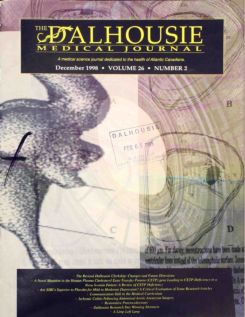A Novel Mutation in the Human Plasma Cholesteryl Ester Transfer Protein (CETP) Gene Leading to CETP-Deficiency in a Nova Scotian Patient: A Review of CETP Deficiency
DOI:
https://doi.org/10.15273/dmj.Vol26No2.4411Abstract
Human Cholesteryl Ester Transfer Protein (CETP) is a 476-residue hydrophobic plasma glycoprotein which catalyzes the hetero-exchange and net mass transfer of cholesteryl esters and triacylglycerols between plasma High Density Lipoprotein (HDL) and Very Low Density (VLDL) and Low Density Lipoproteins (LDL). CETP, together with the plasma enzyme Lecithin:Cholesterol Acyltransferase (LCAT), form integral parts of the Reverse Cholesterol Transport pathway by which cholesterol is removed from peripheral tissues and transported back to the liver for excretion or reutilization. We have recently identified a novel mutation (CT) at nucleotide 836 in Exon 9 of the Cholesteryl Ester Transfer Protein gene from a Caucasian subject resident in Nova Scotia. The patient is homozygous for the mutation which results in the conversion of 268 Arg into a STOP codon and a truncated, dysfunctional protein. This patient is the first Caucasian North American subject reported to have CETP deficiency. The majority of other subjects are of Japanese ancestry. Biochemically, homozygous CETP deficiency is characterized by a moderate hypercholesterolemia (7±0.8 mmol/L) entirely attributable to an elevated HDL cholesterol (4.2±1.0 mmol/L). LDL cholesterol is usually low (2±0.8 mmol/L). Lipoprotein composition is markedly altered with the HDL much larger, cholesteryl ester enriched and triglyceride poor: the LDL is polydisperse. triglyceride enriched, with a lower proportion of cholesteryl ester per particle. The VLDL is similarly cholesteryl ester poor. Here we review the structure and function of CETP. the consequences of CETP deficiency and hence its diagnosis and discuss the current opinions concerning the atherosclerotic risk associated with CETP deficiency and thus the advisability of treating this disorder with cholesterol lowering drugs.
Downloads
How to Cite
Issue
Section
License
Authors who publish with this journal agree to the following terms:
- Authors retain copyright and grant the journal right of first publication with the work simultaneously licensed under a Creative Commons Attribution License that allows others to share the work with an acknowledgement of the work's authorship and initial publication in this journal.
- Authors are able to enter into separate, additional contractual arrangements for the non-exclusive distribution of the journal's published version of the work (e.g., post it to an institutional repository or publish it in a book), with an acknowledgement of its initial publication in this journal.
- Authors are permitted and encouraged to post their work online (e.g., in institutional repositories or on their website) prior to and during the submission process, as it can lead to productive exchanges, as well as earlier and greater citation of published work (See The Effect of Open Access).


